WARNING: THIS POST CONTAINS GRAPHIC IMAGES THAT MAY NOT BE SUITABLE FOR SOME READERS.
Slaughtering a steer is a big job that requires a lot of skill and equipment to be done properly. A block and tackle or hoist would be necessary to haul the carcass up for skinning and gutting. A meat ax is helpful for splitting the carcass in half. After the killing, skinning and gutting are complete, the meat needs to be transported to the butcher in a sanitary manner.
Becky and I knew that all of this was far too much for us to handle on our own. We decided to call in a home kill professional to do the job and transfer the meat to our butcher in town.
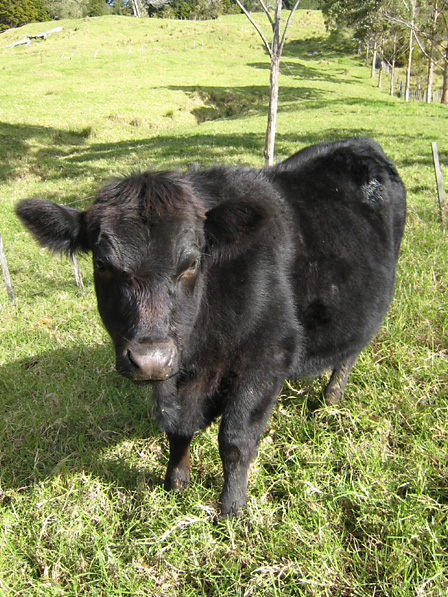
Herman Beefsteak on his last day
Lloyd Johnson has been providing home kill services in New Zealand for twenty years. He’s trying to retire from this work, but rural people continue to call on him. For a cost of $60, Lloyd will do the job neatly and efficiently.
Besides his years of experience, Lloyd brings with him a mobile slaughterhouse in the form of his specialized ute.
All the customer has to do is walk the cow to be slaughtered into the vicinity of that ute and Lloyd will do the rest.
I assumed that I’d do the same thing that I always did when I shifted the cows: Offer a treat bucket to Coco and then walk to where I wanted the rest of the cows to go. They all follow Coco. Except for that day, they didn’t. I don’t know if it was a coincidence, but they wouldn’t follow me down to the front of the paddock, where Lloyd was waiting with his rifle for Herman Beefsteak.
Long story short, eventually Lloyd and I managed to shift Herman into a desirable location for what was about to happen.
I wasn’t really sure how I would feel about slaughtering Herman Beefsteak. I felt… I suppose, matter-of-fact about the situation. From the day this animal was born, Becky and I both knew it would come to this. We gave the animal a care free, stress free life, and now it is going to feed and nourish us and our baby son, Owen. It’s not any more complicated than that for me.
Lloyd stepped close to the steer, aimed the rifle at its head—“Just above the point at which imaginary lines from alternate eyes and horns cross”—and pulled the trigger. The crack of the .22 calibre rifle was followed by great thump as the animal collapsed and rolled onto its right side.
“Get your buckets,” said Lloyd. Becky had instructed Lloyd that she would like to have blood to make black pudding. I retrieved our two stainless steel buckets. (Becky is writing a post dedicated to making the black pudding.)
Lloyd said, “The death throes can be strong. Watch those hooves.”
The animal convulsed powerfully a couple of times, and then settled down.
With one of my buckets in hand and ready, Lloyd cut a long opening, deep into the animal’s neck, severing the main veins and arteries.
Both the volume of blood and the pressure with which is emerged took me by surprise. In a short time, I had about two gallons of blood, far more than necessary for Becky’s black pudding, I was sure. Better to have too much than too little, I figured, and whatever was left over would go right onto the garden beds.
I immediately delivered the buckets of blood to Becky, who was standing by in the kitchen. You’ve got to move fast when making black pudding. She’ll tell you all about it.
Back outside, Lloyd was already at work.
I’m not going to try to describe exactly what he did. He’s such an expert at it, and so fast, that I’m at a bit of a loss to explain it, even though I watched him do it. Luckily, I took pictures.
At the time, I kept thinking, “How is this going to be a one man job?”
Lloyd makes use of clever implements. Probably, the most clever of all is the small hoist and winch system that he custom built onto the back of his ute. This machine deploys in a matter of seconds and allows him to raise the animal up for gutting. The back of the ute itself is all stainless steel, which facilitates the transport of the beef to the butcher in a sanitary manner.
He has metal chocks to position the beast on its back so that it doesn’t roll over as he’s skinning it on the ground.
He uses some kind of stainless steel rods with hooks on both ends to pull bits this way or that. (There’s probably a name for these, but I just don’t know what they’re called.) If he needs some tension applied to the flesh, he hooks one end of the rod in and then he hooks the other end onto a tendon or hoof or another bit of flesh that’s going to pull the way he wants. Look carefully at the pictures and you’ll see this much clearer than I can hope to explain it.
He has an obviously custom built, all metal ax. The blade looks like a heavy duty meat cleaver, but it has a full length ax handle. This is used to actually split the dressed carcass in half.
A high quality stainless steel saw was used once—and only very briefly—on the breast bone, I believe.
He sharpened his knife continuously with a sharpening steel that he wore around his waist.
He had a stainless steel brace that he wore over his shoulders and waist. This assists him with carrying the meat—in quarters—from the hoist to the back of the ute for transport.
He tows a trailer in which the animal’s head, hide and internal organs are carried away. He sells the hide. I don’t know what becomes of the head and the guts. We kept the heart, liver and kidneys.
The process was remarkably neat (considering the scale of the task) and seemed to happen very fast. How fast? You might not believe it, but the job was done in about thirty minutes.
Here’s the story, as told by the images. They run in order.
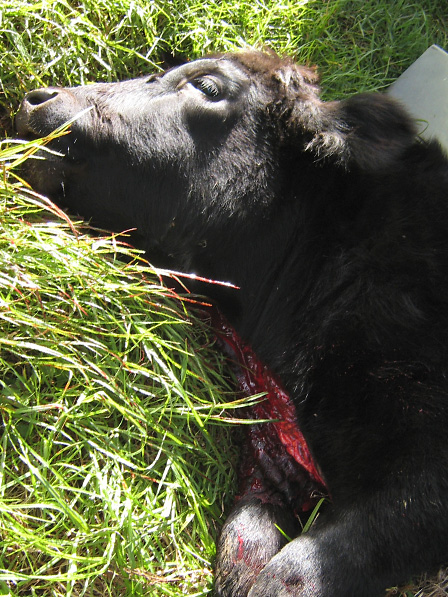


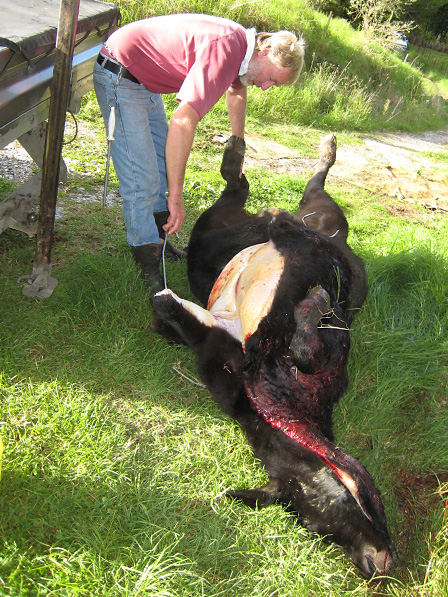








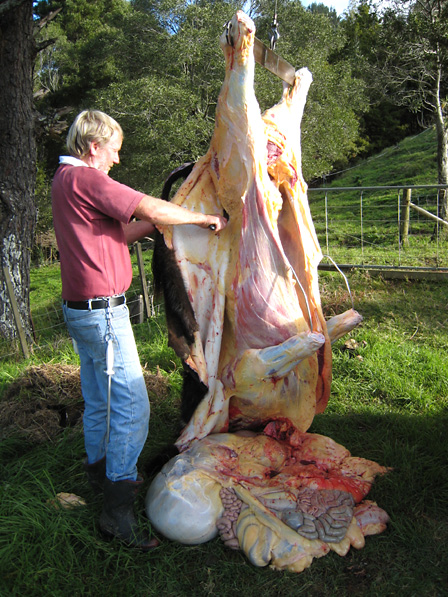




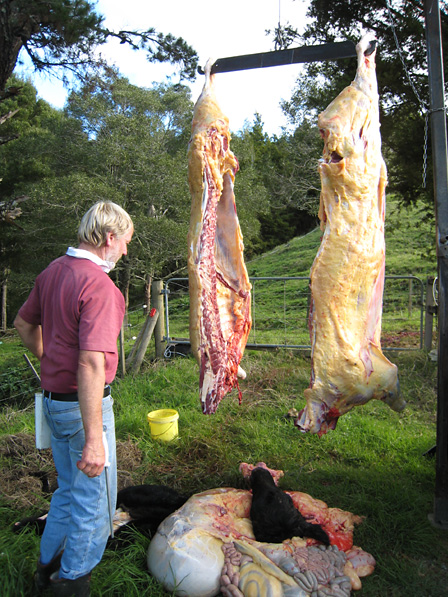
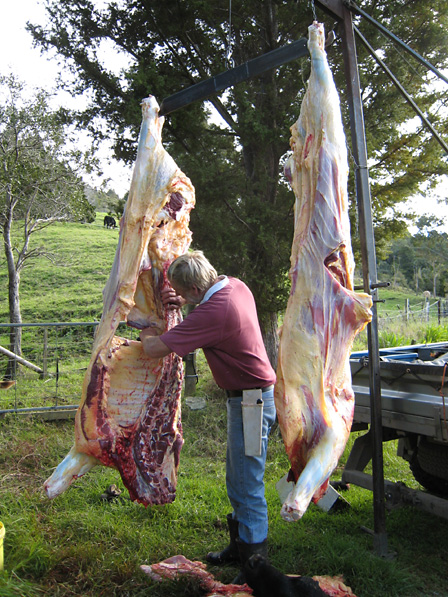


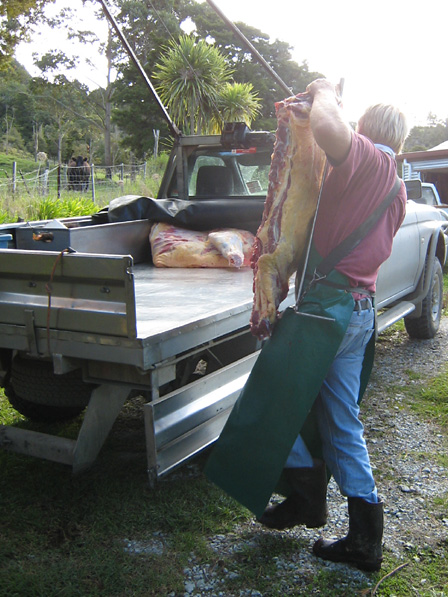

And away it all went to our butcher in town…
Wow. What skill. If all meat was taken in this way…. Thanks for sharing.
Strange how Coco and the other’s knew ‘somethin’s up!
Incredible and I think the worst picture for me was seeing Herman dead with his hide on. Other than that, wow! Such a clean operation!
Someday I’m going to slaughter my pullets when they no longer lay eggs. I think they intuitively know this. Don’t ask me how or why, but they do know it.
After looking at the scope of work it took to lay down Herman, I don’t think it will be too much for me to handle. Thanks for sharing this.
Very neat job, its a shame he looked so cute 🙂 In the pen-ultimate picture you can see another cow looking on, probably contemplating the meaning of life…especially his own 🙂
Great blog – thanks
Great stuff Kevin. You’re so right about his setup. Not a task to be taken lightly, slaughtering a steer, though we shouldn’t forget that guys with stone knives and spears got the job done for thousands of years without his well-prepared rig.
And Eileen, animals ALWAYS know when “something is up”. I beheaded my first nine chickens last month, the remaining hens from the older of the two sets we keep in rotation, in preparation for ten new layers due to arrive any day now.
Having first witnessed the work when I was no more than nine or ten, being done a local farmer who was a long-time friend of my parents, I reviewed what I could recall of his experience and got busy with the hatchet.
The most difficult part of the entire process was getting them positioned on the block with their neck extended, such that it was narrow enough to remove the head clean — in a single chop. The first one went almost too well. This became clear after the second flinched, ending up mortally wounded and requiring a second and third blow. Ack.
By the fifth, I was discovering Les’ (the farmer) special technique via direct observation and was able to consistently get them into position with less trouble — though I will definitely make one small improvement to what is now the “official” (read: bloody) chopping block.
When the time came, the last chicken just KNEW her time was getting short, having just watched the others leave one at a time, hanging by their feet in a giant’s gloved left hand. As I entered the pen, it was cowering in the corner directly opposite the door, looking right at me.
Already well-cornered, I moved slowly toward the corner to collect my prey, only to be rudely surprised as the old gal launched herself two meters in the air, wings flailing furiously. Didn’t expect that. Now in the next corner, as I moved she did it again, touching down right in front of the open door…
…yep, once saw daylight, it was Chicken Run. Down the old stable aisle she charged, with me hot on her shaking tailfeathers. She dove under the stairs to the hay loft. I flushed her and she made for the stable door with another desperate burst of pseudo-flight, making it most of the way and hitting the ground running.
Once outside, she bee-lined for the hedges near the house and “hid” herself in a windowsill, which I discovered after rounding the end of the hedge. Unaware that her favorite hiding roost was unfortunately a bit of a trap, I cornered her there. In that moment, knowing the jig was up, she didn’t even resist. How unusual.
What she did do, however, was to start keening a loud alarm to any and all other chickens in the vivinity, which did not cease until she was across the block and about to meet the great Rooster in the Sky. Then she went dead quiet.
Through all of this, trained killer though I am (technically), this was the first time I have been required to gain personal experience with the taking of another life (thank goodness). It was an odd — and yes, uncomfortable — sensation. Rather like “conscience meets a headache”, but as I am now the senior male of the household, this responsibility falls to me and I must shoulder it like, well… a man.
While it may only be to assuage my conscience, I approached the entire process with a sense of gratitude and somber respect for what I was required to do, and spoke words of thanks and apology to each of the hens as they were on their way to being dispatched. I also left the heads on the back edge of the property as offerings to the large birds of prey in the neighborhood, as our particular neck of the woods is also within a bird sanctuary.
They were all gone the next morning.
Eat well. We’ve already enjoyed our first pot of chicken soup… =)
Good post. Thanks for sharing.
Thanks for this. A well trained butcher is a real, and generally overlooked, asset to the community. Our main meat guy has a similar setup to Lloyd’s, and fortunately, is training a replacement, which is really good news for us….
Try Val’s potroast while you’re putting Herman through his cooking paces…it’s my favorite, after a good grassfed hamburger:
http://www.mossbackfarm.com/archive/000255.html
Rich
Hello Lovelies. Showed Pia the pic’s today which started some interesting discussion about anatomy. She is obviously the descendent of hard working farming folk ’cause she didn’t even flinch. Brett once (half jokingly!) suggested we get the home kill guys in to “do” one of our bantem hens. The image of a tiny hen strung up on a winch behind a blood soaked truck still gets me chuckling!
Good luck with the meat, hope you have plenty of freezer space….if not cuz, you can always courier it to us! A hahaha. xx
i am a city girl through and through, and this story plus all the comments fascinated me. such a wonderful learning experience, and for it to be so well written with photos to boot, i loved it heart and soul, though i shall miss Coco, i would like to think she is happy in animal heaven
@ Cat
HAHA. Bantem hens. You guys will have to come up soon and we’ll have a big Herman feast together.
Hint to Other Readers: Cat is Becky’s cousin.
@ euthymic
That was Herman Beefsteak, not Coco.
Wanted to thank you for the images, as they really got me thinking…about the jarring differences between your setup and what normally occurs at the average US slaughterhouse, for example. I’ve been needing more incentive to buy organic, as my finances don’t normally dictate an ability for that type of splurge. But you reach a point, an AHA moment, where it’s easy to justify the expense. This post was quite interesting for me, as I’ve never seen anything like it before, and I thank you for the education.
What a personal and authentic post about the close of the cycle of steer-raising. This is so so different than the life and slaughter of most of Big Ag’s cattle…I really appreciate your candor in posting the description and pics of the process.
We’ll one day have our own animals to rear …and harvest. We need to know how this experience looks through the eyes of the small homesteader…that’s what we’ll be, too. thank you for sharing.
One of my questions is how you determine what age is the best age to slaughter?
@ Robbyn
Re: the best age to slaughter: I think the question depends on what you’re trying to achieve.
Obviously, the older the animal, the more meat you’ll get. With a younger animal, you will get less meat, but it will be tastier.
In general, the number we always hear is 18 months. Beyond that, you might add a bit more weight, but your meat will be getting tougher. The younger, the more tender it will be.
Herman Beefsteak was 11 months old. This was definitely on the young side. Bex is going to write a “Butchering” post, but I’ll say that our butcher was extremely impressed with the quality of this meat. Treat meat. Special meat. Extra delicious. I don’t know how many decades this woman has been a butcher, but when someone like that delivers these kinds of compliments, we’re thinking that we did pretty well.
Things to keep in mind. Herman had access to mother’s milk until his end day. I looked at the stomach contents and it was mostly grass, but there was some milk. He was fat. Bordering on too fat. Lloyd said he was overfat, our butcher said, “You wouldn’t have wanted it any fatter.”
We’ve also had a very good run with grass over the last year. Herman had been able to fill his guts to the max as much as he wanted and then topped it off with a milk shake.
Both the slaughterman and the butcher guessed that he was older than he was, because of his size. The sire bull was a small Angus and the cow was an average sized Jersey, so Herman did VERY well all around.
So, if you have plenty of grass and want a balance between yield and quality, 18 months would be the answer for here (I don’t know what your pasture/weather conditions are like). If you want “treat meat,” do it earlier.
We have a few acres and a small herd, for the last few animals we have had a farm kill, this guy also does the butchering on site. We help with the packaging and drop the meat straight in the freezer.
So my animals have as nice a life and death as possible and yet at 40 I’ve become a vegetarian. It was for practical reasons more than anything else. Killing, butchering, freezing and cooking all require a lot of skill and hardware. Picking fruit and veg require much less, almost none.
What was the final weight of the carcass pieces delivered to the butcher? Do you have any statistics on how much pounds of what cuts you realized?
I’ve got a 50% interest in a steer that we’ll be slaughtering some time soon with the same kind of procedure — a guy who comes out and does the slaughtering, then we do the butchering.
From Napa, California, I thank you for this informative posting.
Greetings from New Jersey, Very well writen. Answers alot of questions that I had.
Hey Where will I find the info from your wife on the black pudding?